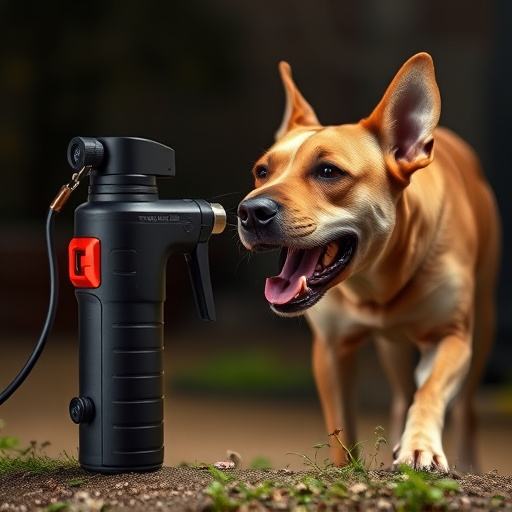Self-defense spray for dog attacks is governed by varying regional regulations, making it vital for pet owners to understand local laws. These rules dictate the type and usage of such sprays while addressing concerns around reasonable force and potential liabilities. When facing a dog attack, strategically target sensitive areas with the spray to disrupt the assailant's senses, creating an escape opportunity. Use as a last resort after de-escalation methods have failed; regular checks on spray accessibility and expiration dates are also crucial for responsible preparation. Balancing personal security and animal welfare requires adhering to local regulations regarding self-defense spray usage around pets.
Staying safe while encountering aggressive dogs is paramount, especially with the rise in dog attacks globally. This article guides you through the world of self-defense spray, a powerful tool for personal protection against canine aggressors. We’ll explore what this spray is, how it works, and its legal standing under Self Defense Spray Regulations, ensuring responsible usage. Learn effective strategies to defend yourself during dog encounters while considering the unique relationship humans share with their pets.
- Understanding Self-Defense Spray: What It Is and How It Works
- Regulations and Legal Considerations for Self-Defense Spray
- Effective Use of Self-Defense Spray Against Dog Attacks
- Pets and Self-Defense Spray: Balancing Safety and Responsibility
Understanding Self-Defense Spray: What It Is and How It Works
Self-defense spray, also known as pepper spray or oleoresin capsicum (OC) spray, is a non-lethal weapon designed to disable and protect individuals from attacks by dogs, among other threats. It’s an aerosol can that releases a chemical agent, typically capsaicin, which irritates the eyes, nose, throat, and lungs of the target, causing temporary blindness, coughing, and difficulty breathing. This disruption gives the user precious time to escape or defend themselves further.
The effectiveness of self-defense spray depends on proper usage and understanding its limitations. Regulations vary by location regarding who can possess and carry such sprays, with some states allowing only law enforcement or specific individuals with permits. Despite these regulations, it’s crucial for pet owners to be aware of local laws surrounding self-defense spray for pets as they walk their dogs, especially in areas with loose leash policies. This awareness ensures responsible usage, promoting safety for both pets and other individuals while navigating public spaces.
Regulations and Legal Considerations for Self-Defense Spray
In many regions, self-defense spray against dogs is governed by specific regulations and legal considerations. It’s crucial to understand these rules before carrying or using such a product to protect yourself from potential dog attacks. The legality of self-defense spray varies significantly from one jurisdiction to another, with some areas completely banning its use while others permit it under certain conditions.
Regulations often focus on the type of spray allowed, the concentration of capsaicin (the active ingredient), and the circumstances under which it can be used. Additionally, legal considerations include issues of reasonable force, consent, and potential liability if the spray is misused or causes harm to others or pets. Pet owners and individuals considering self-defense spray should consult local laws and seek guidance from legal experts to ensure compliance with Self Defense Spray Regulations and to protect themselves from any legal repercussions.
Effective Use of Self-Defense Spray Against Dog Attacks
When facing a dog attack, deploying self-defense spray can be an effective strategy to gain time and create space for escape or help to arrive. It’s important to remember that the use of such sprays is regulated, and understanding local laws regarding pet ownership is crucial before carrying any self-defense tool. The spray should be aimed at the face, eyes, and nose of the attacking dog, as these areas are highly sensitive. A well-timed, direct blast can disrupt the dog’s attack pattern, allowing you to move away quickly and safely.
Training in the proper use of self-defense spray is essential for maximizing its effectiveness during a real-life encounter. This includes learning how to assess the situation, choose the right target areas on the dog, and understand the range and duration of the spray’s impact. While it can be a powerful tool against aggressive dogs, it should only be used as a last resort when all other de-escalation methods have failed or are not feasible. Additionally, keeping your spray readily accessible, knowing its expiration date, and regularly checking local regulations regarding its possession and use is vital for responsible self-defense preparation against dog attacks.
Pets and Self-Defense Spray: Balancing Safety and Responsibility
In many regions, self-defense spray is a popular tool for personal safety, especially when encountering potentially aggressive animals like dogs. However, the use of such spray on pets or in areas where animals roam freely raises ethical concerns and comes with regulations. Self-defense spray laws vary across locations, with some places restricting its use against animals to prevent harm and promote responsible ownership.
Pet owners need to be mindful of these rules and understand their obligations to ensure the safety of both themselves and other animals. Balancing personal security with animal welfare requires users to employ spray only as a last resort when facing an imminent threat from an aggressive dog, and to familiarize themselves with local laws regarding its usage.
Understanding the legal framework surrounding self-defense spray, especially regarding pet safety, is crucial. While it offers a powerful tool for protection against dog attacks, responsible usage and awareness of local regulations are essential. By balancing safety measures with pet ownership, individuals can effectively defend themselves while ensuring their four-legged companions’ well-being. This balanced approach to self-defense spray use fosters a harmonious coexistence between personal security and the responsibilities of pet ownership.
